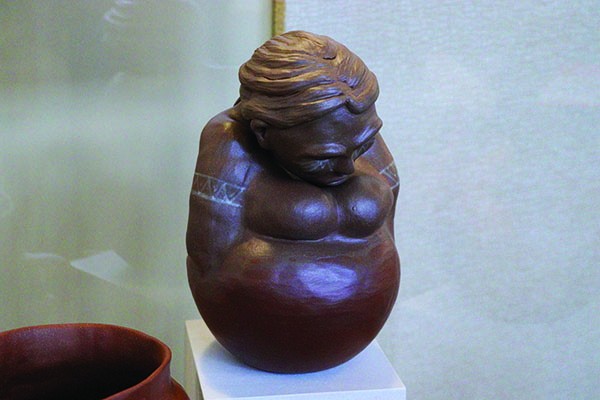By SCOTT MCKIE B.P.
One Feather Staff
The art of Cherokee pottery is alive and well and is moving into the 21st century with renewed vigor. Students in a class entitled Traditional Pottery for Beginners, tau

A pot by Lori Reed was one of the pieces featured in a pottery exhibit held at the Museum of the Cherokee Indian on Friday, April 8. The exhibit was held for students who completed a class taught recently by Cherokee potter Tara McCoy entitled Traditional Pottery for Beginners. (SCOTT MCKIE B.P./One Feather photo)
ght by Cherokee potter Tara McCoy and hosted by the Museum of the Cherokee Indians, showed the work they accomplished during the class in an exhibit at the Museum which opened on Friday, April 8.
The class was held free of charge for members of the Eastern Band of Cherokee Indians (EBCI) and was part of the Museum’s Community Learning Initiative.
“Pottery has been may main passion for probably the last 23 years,” McCoy told the crowd as she introduced the exhibit on Friday night.
“With this three-month series, we tried a lot of techniques. We taught feet and handles. We talked about the fire pot, and you’ll see all these as you walk around. We also did a syllabary pot. I wanted to incorporate the syllabary. We have a legend pot. So, it’s a little bit more than pottery class. I wanted to incorporate our language and our stories, the culture. And, I wanted to incorporate gadugi and our seven core values. And, I wanted to connect them to the past because our ancestors have always made pottery. We used to cook in it, store things in it, carry water. So I wanted to take them back to the past because they’re using the same clay, or the same dirt, they’re using the same designs and they’re using the same tools that our ancestors would have used a long time ago.”
McCoy praised her students, “All of the people in the class did awesome work. I like seeing them get excited. I like seeing them get excited about dirt. We dug dirt and processed it, and I just like seeing them get excited about it. I like to see that passion. I think you need to find that passion and share it with people so that they can get excited about something, whether it be the language, the arts, clothing.”
Dr. Blythe Winchester, Cherokee Indian Hospital director of geriatric services, said, “So, this was a three-month series of classes, one weekend per month. But, we also had homework assignments for different pots to make – a syllabary pot, an effigy pot, a pot with handles, a legends pot – so that we were supposed to complete those in-between. So, I think that’s why we were able to make so much is that we were really passionate and we worked on our pots on days other than the days we had class.”
She added, “She did teach us a ton of new techniques. You can see we learned how to make fire pots, we learned how to make pots with handles, we learned how to paint with what’s called slip, so it’s crazy. When I look at this, I can see how much we learned.”
Dr. Winchester said creativity was at the forefront of the class. “I think that’s why I love this. This is all traditional pottery, but you can really see everyone’s creativity in each style. Just because we were assigned to do an effigy pot, doesn’t mean that anybody is going to have the same animal. We’re not going to have the same legend for our legend pot. You do want to improve and grow, so I was trying to really challenge myself. I did it.”
Lori Reed has been doing pottery for years and is an arts and crafts instructor at Cherokee Central Schools. “This class was really helpful for me. I learned how to do the fire pot. I never really knew how to do it. I tried to do one before and my little things fell off, so I wasn’t very successful. Another thing that I really learned was how to do the feet. You think you can just put it on there and it’ll stay, but they don’t stay. So that was another good thing that I learned how to do. It made me happy because it made me feel like ‘wow, now I have new skills that I can go back and teach my kids.”
Reed said she relished the new ideas and techniques presented in the class. “She kind of gave us things to think about. We would get stuck kind of doing the same thing, the same shape. And, with those different things you have to really think about how you want to do it.”
She added, “I’ve been wanting to make an effigy pot…but I’ve never done anything this big. I’m super excited to work on that and I love how she turned out. I think one of the things about this class is that Tara made us use different types of clay. You can really see that different types of clay can do different things.”
Shana Bushyhead-Condill, Museum of the Cherokee Indian executive director, said she is very pleased with how the class turned out – especially all of the new pottery produced. “I’m passionate about all the work that we’re doing. And, the class that Tara decided to host here exemplifies what we’re trying to do here at the Museum of the Cherokee Indian. I think one of the things that make this work so rewarding is watching when folks have passion for teaching and passing on tradition. I’m grateful to Tara for her work in making this class a reality.”
She hopes classes like this continue and expand, “This is what we hope is a seed that’s planted that grows even bigger. I was in a meeting talking about Native ceramics from the East Coast and one of the women said, ‘Whatever I make, makes it Native art’ and I love that! Each of these pieces is so individualistic. You can see every artist’s personality in these pieces and that’s what makes it Cherokee is that it came from that person that made it. We’re here to support that. The Museum, I don’t believe, is ever about the past. It’s about who we are and who we want to be and where we’re going in the future.”
McCoy agrees, “One of the reasons why I wanted to do this class…I’ve done some in the past, but it was just like one weekend. You couldn’t really teach much so I decided I wanted to do it in a three-month series mainly because I’ve seen a decline in potters and a decline in pottery-making in general.”
She went on to say, “I want to put Cherokee art on the map on this side of the coast because our people are so beautiful, smart, and intelligent, we’re rich in culture in the art and the language and I just think that needs to be showcased. So, that’s why I’m passionate about it. I also want to increase not only the quantity but the quality of the art. We’ve already got some wonderful, awesome artists. I just want to make that step up to another level and not put it as a competition among one another, but to make it a competition among yourself.”





